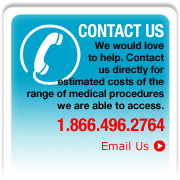
|
|
Hernia RepairEvery year, thousands of clients that are uninsured, under-insured or self-insured turn to North American Surgery Inc. to have their surgeries performed close to home at or below the cost of overseas procedures. Why travel great distances and take unnecessary risks for uninsured medical procedures such as hernia repair surgery when affordable alternatives exist in the US? If you need hernia repair surgery, but you are uninsured, North American Surgery can help you. What is a hernia and why do I need hernia repair surgery?A hernia occurs when an organ or tissue protrudes through an abnormal opening in the body. The most common is an inguinal (groin) hernia, which represents more than 90 percent of hernias that occur. This happens when a small piece of the bowel bulges out through a hole or weakness in the inguinal canal, which is a passage through the muscles of the abdominal wall. As a result, a piece of bowel bulges into the groin. This can occur in both men and women but is much more common in men. Direct inguinal hernias occur when a weak spot develops in the lower abdominal muscles. Indirect inguinal hernias occur when the inguinal canal has failed to close before birth. Other types of hernias, which represent less than 1 percent of total hernias include: incisional (relating to a previous surgery), ventral (relating to a defect in the muscles of the abdomen), umbilical (a weakness at the navel), femoral (relating to the blood vessels between the groin and the leg – and more common in women), and hiatal (relating to the diaphragm.) You may notice your hernia as a lump or a bulge. Hernias often cause pain and sometimes a feeling of pressure, burning, “gurgling” or weakness. You may notice that the pain or feelings become stronger as you spend time standing or if you do any straining or lifting. Some people live with hernias for years. The downside of this is not just the pain, however. Ignoring a hernia increases the risk of what’s called incarceration (the hernia gets stuck where it has protruded) and strangulation (blood supply to the trapped tissue is cut off.) What are the different hernia repair options for me?Open surgery is the most common technique for repair of an inguinal hernia. The biggest advantage is that it can usually be done with a local anesthetic. The surgeon makes an incision over the site of the hernia and then returns the protruding tissue to the abdominal area. He or she then repairs the hole or weakness by sewing surrounding muscles over the defect. Alternatively, and more commonly today, the surgeon will simply insert a piece of mesh to cover the area of the defect without sewing together the surrounding muscles. In some patients, surgeons may suggest a laparoscopy rather than open surgery for repair of an inguinal hernia. This means the surgeon will perform the hernia repair using a laparoscope – a special and very small telescope used to examine the inside of the body. While you are asleep under a general anesthetic, the surgeon makes small incision and using a narrow tube-like instrument known as a cannula, inserts the laparoscope. Then, making several other small incisions, he or she inserts instruments and repairs the hernia. The advantage of a laparoscopy is that it offers a faster recovery time and usually, less pain. The disadvantage is that it requires a general anesthetic and is not suitable for all patients. Your surgeon is the best person to help you decide what approach will be best for you. What are the risks of hernia repair surgery?All surgeries carry some risk, including but not limited to the risk of anesthesia, bleeding, infection, pneumonia and blood clots. Potential complications relating specifically to hernia repair surgery may include unintended injury to surrounding structures such as the intestine or the bladder. Since the laparoscopic method of hernia repair is relatively new, its possible complications aren’t as well known as the complications associated with other methods. Your surgeon is the best person to assess your risks and discuss how to minimize them. How long will it take me to recover from hernia repair surgery?Recovery time will depend on the location and type of hernia and on the nature of your surgery. Following a laparoscopy, it is likely you can return home the same day and the total recovery time is usually one to two weeks. Following an open surgical hernia repair, you may need to stay in hospital for a day or so and your total recovery time will be four to six weeks. What can I expect when I’m fully recovered?Most hernia repair surgeries are extremely successful. In a small percentage of cases, the hernia will recur and need to be repaired again. What to do if you are Uninsured, Under-Insured or Self-InsuredNorth American Surgery Inc. acts as a facilitator, bringing our clients together with private medical clinics and hospitals that can provide the needed services and/or procedures in a timely manner and at affordable prices to the uninsured. If you are uninsured and want more information about private medical care, contact North American Surgery Inc. today. |




|
SITEMAP | Copyright 2025 North American Surgery |
About UsFor the last four years we have been facilitating surgical procedures for clients wishing to access the favorable pricing which we have negotiated with hospitals and clinics across the country. |
ServicesNorth American Surgery Inc. is able to access reasonably priced surgical procedures of all types in U.S. based facilities. Our clients pay a small fraction of the standard prices charged by most U.S. hospitals. Typically the prices we have negotiated are comparable to the costs associated with off-shore surgery in places such as India, Thailand or Mexico. |
ProcedureThe role of our firm is to act as a facilitator, brining our clients together with private medical services and clinics which can provide the needed services and / or procedures in a timely manner. Once arrangements have been made to the mutual satisfaction of our client and their physician, we have no ongoing involvement in the doctor-patient relationship. |
NEWSFAQsTestimonialsLinks |